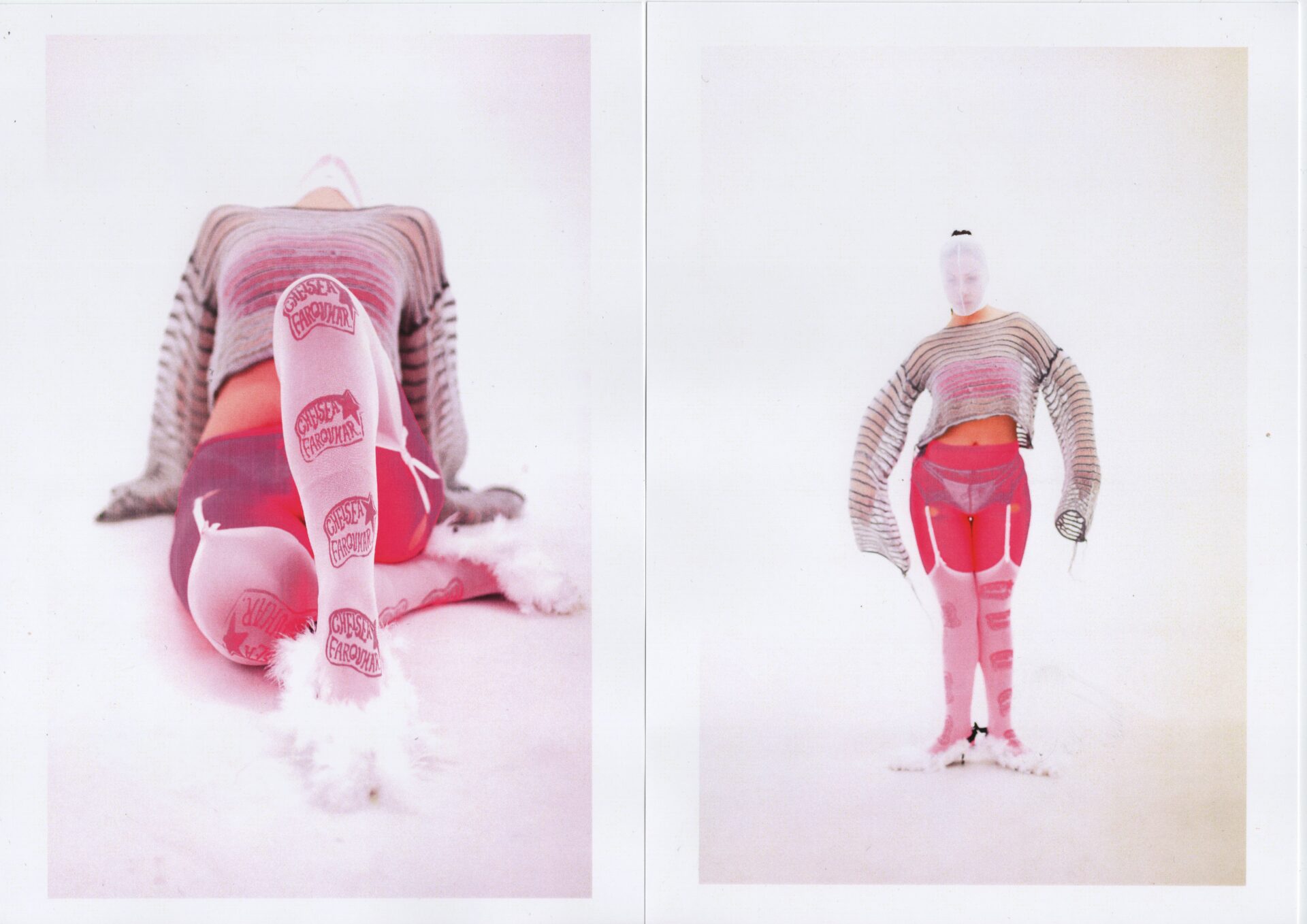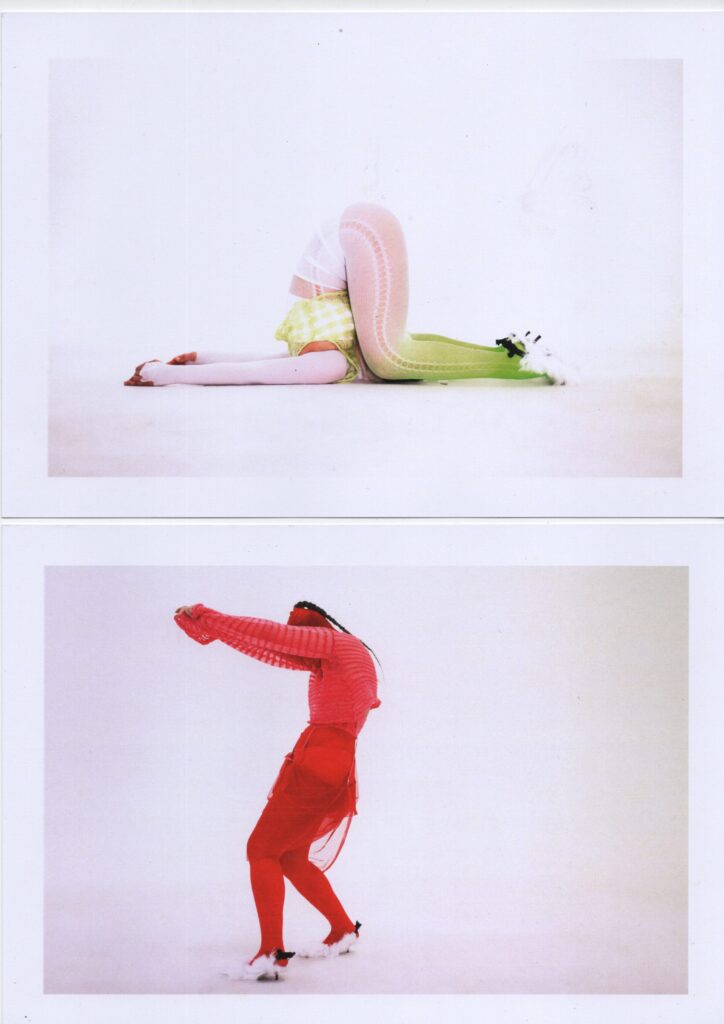Artist Chelsea Farquhar Moves into Clothes

Adelaide-based contemporary artist Chelsea Farquhar recently launched her first collection for her eponymous fashion brand and, more recently, took part in the 2024 Unarchived runway by the Emerging Artist Collective in Melbourne, Australia.
From the comfort of their respective beds, Sydney-based stylist, producer, friend and creative collaborator Sharmonie Cockayne sat down with Chelsea to chat about the beginning of her artistic practice, her entry into fashion, how she plays within the space between historic fashion, considers the body as a sculptural expression and dreams of designing for K-pop girls and boys.
Sharmonie Cockayne The collection that you and I shot together is comprised of knit pieces, which you recently showed at the Melbourne runway. They are different to the pieces you have made in the past. What do you consider to be the through line? How do they sit under the same umbrella of Chelsea Farquhar?
Chelsea Farquhar I wanted to limit myself to produce something new. I’ve been learning how to use the knitting machine for like 16 months now and eventually got to a point where I wanted to consolidate that learning with an outcome and see what I could do within my own parameters. I wanted to really limit myself. I gave myself a few months and I only bought yarns from op shops, which determined the colours, and then I decided on one technique, which was that striped wobble technique. I would do five rows with a really tight tension with two threads at once; then I would do five more rows with a really loose tension with one thread, which creates that 3D texture.
There’s so much going on in my practice. I do a bit of everything. It’s hard to focus. I think the knits feel really random for me, and that’s because they are.
SC Do you see the pieces as art?
CF I feel more comfortable making artwork, but whenever I call them ‘clothes’ or ‘fashion’ I always feel a bit uncomfortable. I feel out of my depth in the fashion world.
SC So your knitting proved that you could also make clothes rather than always be artistic?
CF Potentially? Or they proved that I could put something out into the world that wasn’t perfect. It was almost a way to force myself to tell everybody that I wanted to make clothes now.
SC Why do you want to make clothes now?
CF I’ve been doing it forever. I just don’t tell anybody. Even when I was at art school, I used to make jumpers.
SC Wait, what were you making at art school?
CF I was making this link inspired by the work of Erwin Wurm. He’s an Austrian conceptual artist-slash-sculptor. He would manipulate clothes, or he would make simple clothes and then ask the viewer to manipulate their body to fit into the clothes in abstract ways. He would treat the body as an object and the viewer as the performer. I used to chop up jumpers, sew sleeves together and make people wear them. It was weird. I also did heaps of embroidery at art school. I was a textile queen. Then I started making sculptures and in 2020, I started sewing.
SC Sculptures is broad. Can you describe the sculptures?
CF Yes, it is a very broad term. It was a lot of plaster because I liked casting things. There are lots of body pieces as well. The through line in my practice has always been the body. It’s always been about other people and it’s always been about bodies and how we relate to objects, people, places and things.

SC Can you remember the first time you became aware of bodies as a concept? Or your own body?
CF My mum is a nurse, so I grew up aware of bodies and learning about bodies. I went to art school because I wanted to do anatomical illustration.
SC Really?
CF Yes, I wanted to draw organs.
SC How long did it take you to figure out your direction?
CF I was in first year of art school.
SC Did you ever do a research project in Year 12? Mine explored the intersection between art and fashion. I looked at couture makers and read all of these interviews from the designers, who I thought were not designers but were actually artists who used design or fashion as their medium. I think we approach fashion in a similar way, or our idea of ‘fashion’ is pure in the same way. We come at it from different places. I am a fashion stylist; you are an artist.
CF I didn’t think I was ‘in fashion’ until you put me there.
SC You were in fashion from the start, girl.
CF Yeah, but I think you put me there. You made me realise that I could join this world.
SC You were always there in my eyes.
CF I wouldn’t say I always looked to fashion designers. I do now, though. I look mostly at historical fashion and historic fashion, like patterns and sculptors who use patterns. I still come from an art space and always look at sculptors who sew and use 2D pattern work to think about object making and sculpture.
I often look at Janet Arnold books; she was a fashion historian and used to go to archaeological dig sites and pull up old clothes, like 14th-century corsets and basically work out how they were made. She would dissect them, make patterns from them and then make those patterns available. I would use those patterns to start my process when I approached making corsets or anything historic. I would try to replicate it following her steps. I don’t need things to be historic; I just like using that as a reference point and then just seeing where they goes.
SC My grandma is an artist, and she won’t let us call her an artist. She sews and does quilting. It’s fun.
CF I think fun is what pulls me along. I don’t find following instructions very fun, but I do know that it is important. I do really love learning how things work.
SC You make a lot, Chelsea.
CK It’s a bit compulsive.

SC If you weren’t making, what would your life be filled with?
CK You know, it’s so funny. I’ve tried to stop being an artist about three times now I can’t escape it.
SC That’s what makes you an artist, though.
CF Yeah, I think I’ve finally accepted that I am an artist.
SC The word that keeps returning in your work is ‘Histrionics’. You said this word when we were both at Adelaide Contemporary Experimental. What does ‘histrionics’ mean?
CF Histrionics came up when Megan, the curator of the ACE Studio Program that year, used it in an essay about my work. It basically means attention-seeking. It’s such a camp word, that basically means that you are a bit of a diva or that you’re acting out. It’s a perfect word that describes my practice, I think.
SC How did you go from corsets to knitwear?
CF I think they all live in the same place in my brain. They’re doing different things, but they're both kind of playing with ideas of the body. Knits come into play in the styling of all the stockings and the tights, and Ava’s hair, and then also in the choreography of poses. Those knits were about this stretch, this push and pull of the body—that’s why they’re so long. Those knits bounce when you move. They have this amazing life ahead of them. And then the corsets were also doing a similar thing. They both play with the body.
That’s why I really wanted Ava to do those funny poses: do the splits, do the backbends; I really wanted to contort her body. I wanted the shoot to feel really minimal, but I also wanted Ava to enact what the knits were doing.
SC You’ve been letting stylists loan your art pieces for shoots for a while. Has that made you more comfortable with the fashion industry?
CF That’s the best part. I think that was where I got my confidence from. It’s one thing to take photos with friends and to like them. It’s another thing for a stylist to put the pieces on people you don’t even know with photographers you don’t know and see those photos come back and see your works living in another world. I love when stylists borrow my clothes, and I love when stylists use my clothes in ways that I don’t think of.
SC Who would you like to design pieces for?
CF Am I allowed to say K-pop?
SC That’s why I asked you the question.
CF You’re baiting me! Obviously, the K-pop girls. The girls and the boys of K-pop. The clothes and the styling in K-pop are so exciting and inspiring.
SC What about it is exciting and inspiring?
CF They’re taking risks, and you don’t even know what they’re thinking. You can’t understand the logic that goes into their outfits. They’re so bizarre. And even when it’s bad, you still think, Well, maybe it’s good.
SC Are you working on anything right now? What is your vision for the Chelsea Farquhar brand?
CF I imagine that in the next few years my clothing is going to look pretty disjointed until it eventually starts to narrow into a bigger identity.

Babydilf on Sex, Love and Glory Holes
By Mark Bo Chu
Beneath Thibaut Grevet's Blurry Lines
By Anna Prudhomme
Nalin Satearrujikanon: The Future Is Ladyboy
By Lisabel Link
Prada’s SS24 Womens: More than Slime at Milan Fashion Week
By Hugh Barton
Diego Ramírez
Vampires of the Earth
By Georgia Puiatti
Balenciaga Couture: Where Elegance Meets Audacity
By Emily Lederman
